Bioscience 2 (401006) Case Study: Conjunctivitis Infection Analysis
VerifiedAdded on 2022/10/15
|9
|1954
|13
Case Study
AI Summary
This case study examines a scenario of infectious conjunctivitis, focusing on a patient in a nursing home. The solution details the identification of the causative agent (Staphylococcus aureus), the mechanism of action of the prescribed antibiotic (gentamicin), and the physiological basis for the observed signs like redness, swelling, and discharge. The case study also explores infection control issues, including the contagious nature of the infection and the potential for antimicrobial resistance. Furthermore, it analyzes the transmission of the infection, identifying potential routes and susceptible hosts, and proposes strategies to break the chain of infection, such as strict hand hygiene and infection control protocols. The assignment also includes a discussion on the presentation of the case study, highlighting the references used.
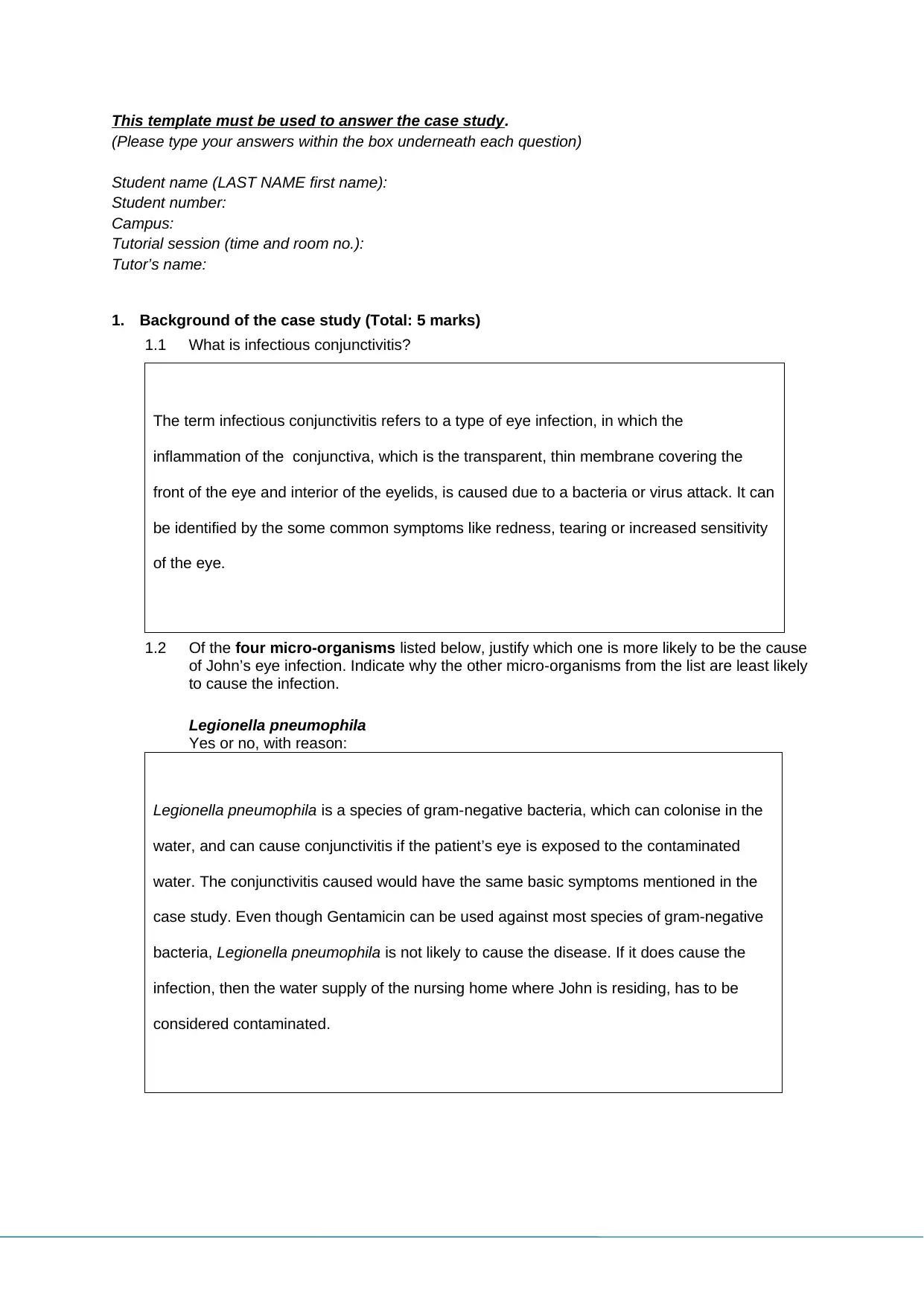
This template must be used to answer the case study.
(Please type your answers within the box underneath each question)
Student name (LAST NAME first name):
Student number:
Campus:
Tutorial session (time and room no.):
Tutor’s name:
1. Background of the case study (Total: 5 marks)
1.1 What is infectious conjunctivitis?
The term infectious conjunctivitis refers to a type of eye infection, in which the
inflammation of the conjunctiva, which is the transparent, thin membrane covering the
front of the eye and interior of the eyelids, is caused due to a bacteria or virus attack. It can
be identified by the some common symptoms like redness, tearing or increased sensitivity
of the eye.
1.2 Of the four micro-organisms listed below, justify which one is more likely to be the cause
of John’s eye infection. Indicate why the other micro-organisms from the list are least likely
to cause the infection.
Legionella pneumophila
Yes or no, with reason:
Legionella pneumophila is a species of gram-negative bacteria, which can colonise in the
water, and can cause conjunctivitis if the patient’s eye is exposed to the contaminated
water. The conjunctivitis caused would have the same basic symptoms mentioned in the
case study. Even though Gentamicin can be used against most species of gram-negative
bacteria, Legionella pneumophila is not likely to cause the disease. If it does cause the
infection, then the water supply of the nursing home where John is residing, has to be
considered contaminated.
(Please type your answers within the box underneath each question)
Student name (LAST NAME first name):
Student number:
Campus:
Tutorial session (time and room no.):
Tutor’s name:
1. Background of the case study (Total: 5 marks)
1.1 What is infectious conjunctivitis?
The term infectious conjunctivitis refers to a type of eye infection, in which the
inflammation of the conjunctiva, which is the transparent, thin membrane covering the
front of the eye and interior of the eyelids, is caused due to a bacteria or virus attack. It can
be identified by the some common symptoms like redness, tearing or increased sensitivity
of the eye.
1.2 Of the four micro-organisms listed below, justify which one is more likely to be the cause
of John’s eye infection. Indicate why the other micro-organisms from the list are least likely
to cause the infection.
Legionella pneumophila
Yes or no, with reason:
Legionella pneumophila is a species of gram-negative bacteria, which can colonise in the
water, and can cause conjunctivitis if the patient’s eye is exposed to the contaminated
water. The conjunctivitis caused would have the same basic symptoms mentioned in the
case study. Even though Gentamicin can be used against most species of gram-negative
bacteria, Legionella pneumophila is not likely to cause the disease. If it does cause the
infection, then the water supply of the nursing home where John is residing, has to be
considered contaminated.
Paraphrase This Document
Need a fresh take? Get an instant paraphrase of this document with our AI Paraphraser
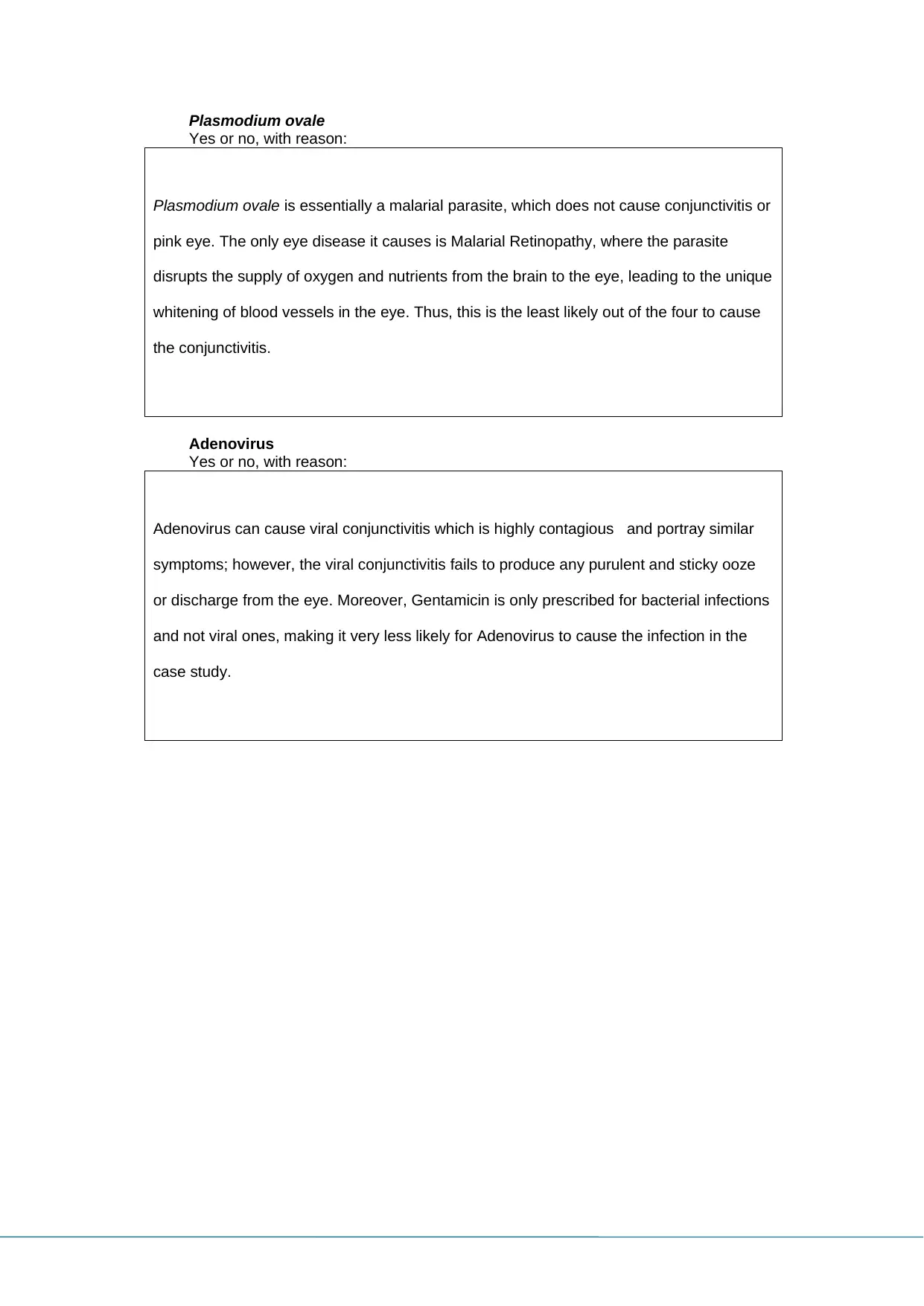
Plasmodium ovale
Yes or no, with reason:
Plasmodium ovale is essentially a malarial parasite, which does not cause conjunctivitis or
pink eye. The only eye disease it causes is Malarial Retinopathy, where the parasite
disrupts the supply of oxygen and nutrients from the brain to the eye, leading to the unique
whitening of blood vessels in the eye. Thus, this is the least likely out of the four to cause
the conjunctivitis.
Adenovirus
Yes or no, with reason:
Adenovirus can cause viral conjunctivitis which is highly contagious and portray similar
symptoms; however, the viral conjunctivitis fails to produce any purulent and sticky ooze
or discharge from the eye. Moreover, Gentamicin is only prescribed for bacterial infections
and not viral ones, making it very less likely for Adenovirus to cause the infection in the
case study.
Yes or no, with reason:
Plasmodium ovale is essentially a malarial parasite, which does not cause conjunctivitis or
pink eye. The only eye disease it causes is Malarial Retinopathy, where the parasite
disrupts the supply of oxygen and nutrients from the brain to the eye, leading to the unique
whitening of blood vessels in the eye. Thus, this is the least likely out of the four to cause
the conjunctivitis.
Adenovirus
Yes or no, with reason:
Adenovirus can cause viral conjunctivitis which is highly contagious and portray similar
symptoms; however, the viral conjunctivitis fails to produce any purulent and sticky ooze
or discharge from the eye. Moreover, Gentamicin is only prescribed for bacterial infections
and not viral ones, making it very less likely for Adenovirus to cause the infection in the
case study.
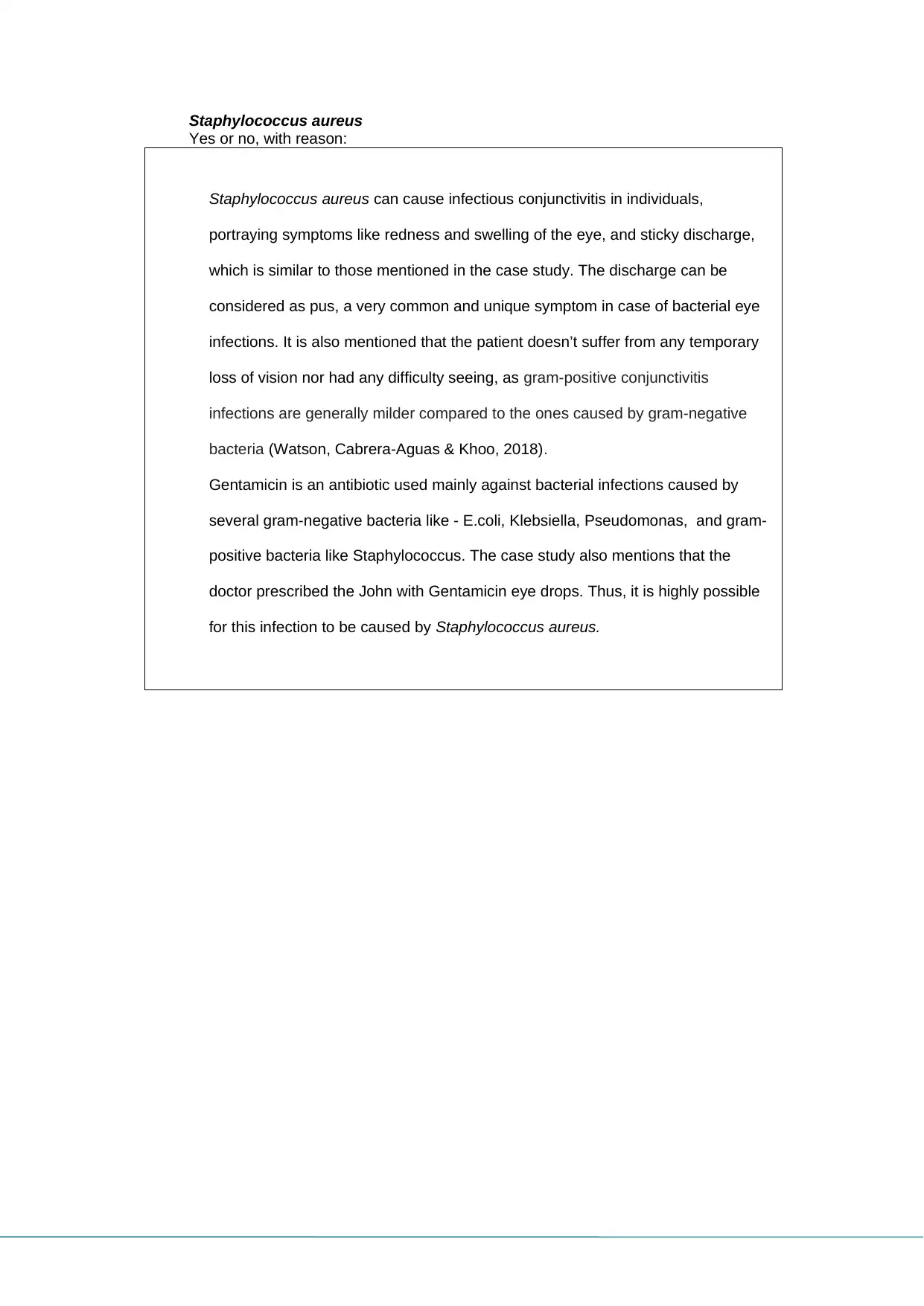
Staphylococcus aureus
Yes or no, with reason:
Staphylococcus aureus can cause infectious conjunctivitis in individuals,
portraying symptoms like redness and swelling of the eye, and sticky discharge,
which is similar to those mentioned in the case study. The discharge can be
considered as pus, a very common and unique symptom in case of bacterial eye
infections. It is also mentioned that the patient doesn’t suffer from any temporary
loss of vision nor had any difficulty seeing, as gram-positive conjunctivitis
infections are generally milder compared to the ones caused by gram-negative
bacteria (Watson, Cabrera-Aguas & Khoo, 2018).
Gentamicin is an antibiotic used mainly against bacterial infections caused by
several gram-negative bacteria like - E.coli, Klebsiella, Pseudomonas, and gram-
positive bacteria like Staphylococcus. The case study also mentions that the
doctor prescribed the John with Gentamicin eye drops. Thus, it is highly possible
for this infection to be caused by Staphylococcus aureus.
Yes or no, with reason:
Staphylococcus aureus can cause infectious conjunctivitis in individuals,
portraying symptoms like redness and swelling of the eye, and sticky discharge,
which is similar to those mentioned in the case study. The discharge can be
considered as pus, a very common and unique symptom in case of bacterial eye
infections. It is also mentioned that the patient doesn’t suffer from any temporary
loss of vision nor had any difficulty seeing, as gram-positive conjunctivitis
infections are generally milder compared to the ones caused by gram-negative
bacteria (Watson, Cabrera-Aguas & Khoo, 2018).
Gentamicin is an antibiotic used mainly against bacterial infections caused by
several gram-negative bacteria like - E.coli, Klebsiella, Pseudomonas, and gram-
positive bacteria like Staphylococcus. The case study also mentions that the
doctor prescribed the John with Gentamicin eye drops. Thus, it is highly possible
for this infection to be caused by Staphylococcus aureus.
⊘ This is a preview!⊘
Do you want full access?
Subscribe today to unlock all pages.

Trusted by 1+ million students worldwide
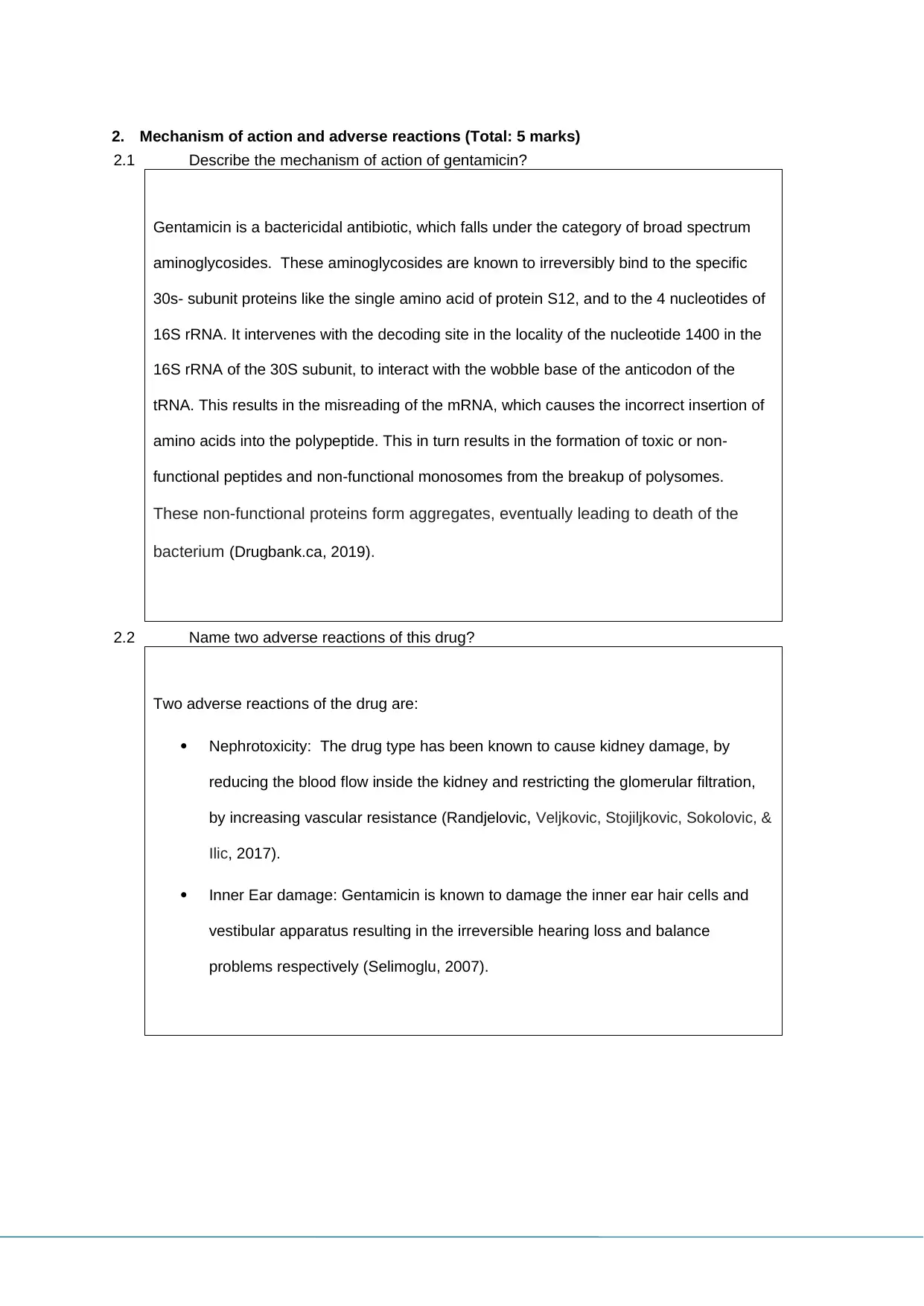
2. Mechanism of action and adverse reactions (Total: 5 marks)
2.1 Describe the mechanism of action of gentamicin?
Gentamicin is a bactericidal antibiotic, which falls under the category of broad spectrum
aminoglycosides. These aminoglycosides are known to irreversibly bind to the specific
30s- subunit proteins like the single amino acid of protein S12, and to the 4 nucleotides of
16S rRNA. It intervenes with the decoding site in the locality of the nucleotide 1400 in the
16S rRNA of the 30S subunit, to interact with the wobble base of the anticodon of the
tRNA. This results in the misreading of the mRNA, which causes the incorrect insertion of
amino acids into the polypeptide. This in turn results in the formation of toxic or non-
functional peptides and non-functional monosomes from the breakup of polysomes.
These non-functional proteins form aggregates, eventually leading to death of the
bacterium (Drugbank.ca, 2019).
2.2 Name two adverse reactions of this drug?
Two adverse reactions of the drug are:
Nephrotoxicity: The drug type has been known to cause kidney damage, by
reducing the blood flow inside the kidney and restricting the glomerular filtration,
by increasing vascular resistance (Randjelovic, Veljkovic, Stojiljkovic, Sokolovic, &
Ilic, 2017).
Inner Ear damage: Gentamicin is known to damage the inner ear hair cells and
vestibular apparatus resulting in the irreversible hearing loss and balance
problems respectively (Selimoglu, 2007).
2.1 Describe the mechanism of action of gentamicin?
Gentamicin is a bactericidal antibiotic, which falls under the category of broad spectrum
aminoglycosides. These aminoglycosides are known to irreversibly bind to the specific
30s- subunit proteins like the single amino acid of protein S12, and to the 4 nucleotides of
16S rRNA. It intervenes with the decoding site in the locality of the nucleotide 1400 in the
16S rRNA of the 30S subunit, to interact with the wobble base of the anticodon of the
tRNA. This results in the misreading of the mRNA, which causes the incorrect insertion of
amino acids into the polypeptide. This in turn results in the formation of toxic or non-
functional peptides and non-functional monosomes from the breakup of polysomes.
These non-functional proteins form aggregates, eventually leading to death of the
bacterium (Drugbank.ca, 2019).
2.2 Name two adverse reactions of this drug?
Two adverse reactions of the drug are:
Nephrotoxicity: The drug type has been known to cause kidney damage, by
reducing the blood flow inside the kidney and restricting the glomerular filtration,
by increasing vascular resistance (Randjelovic, Veljkovic, Stojiljkovic, Sokolovic, &
Ilic, 2017).
Inner Ear damage: Gentamicin is known to damage the inner ear hair cells and
vestibular apparatus resulting in the irreversible hearing loss and balance
problems respectively (Selimoglu, 2007).
Paraphrase This Document
Need a fresh take? Get an instant paraphrase of this document with our AI Paraphraser
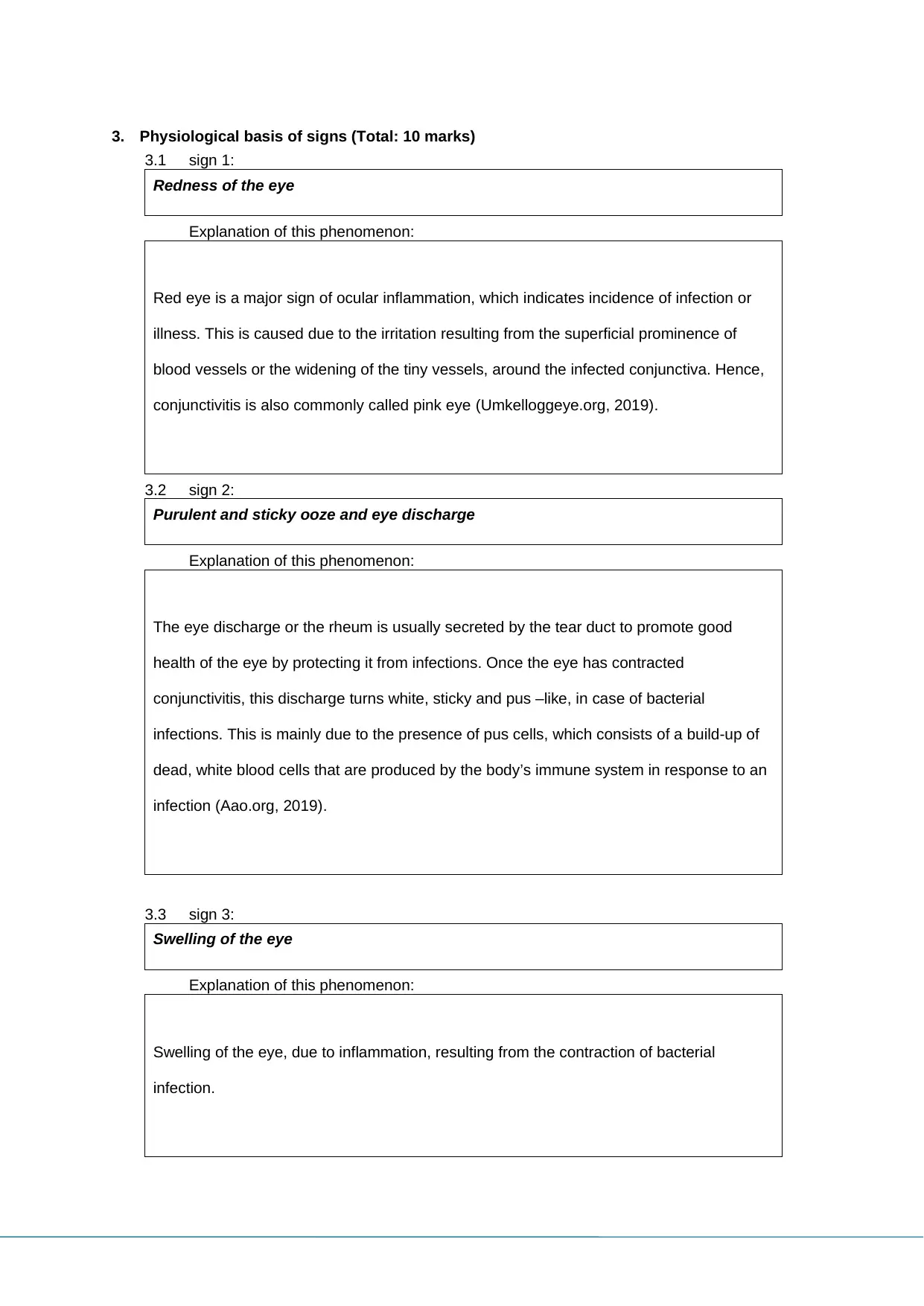
3. Physiological basis of signs (Total: 10 marks)
3.1 sign 1:
Redness of the eye
Explanation of this phenomenon:
Red eye is a major sign of ocular inflammation, which indicates incidence of infection or
illness. This is caused due to the irritation resulting from the superficial prominence of
blood vessels or the widening of the tiny vessels, around the infected conjunctiva. Hence,
conjunctivitis is also commonly called pink eye (Umkelloggeye.org, 2019).
3.2 sign 2:
Purulent and sticky ooze and eye discharge
Explanation of this phenomenon:
The eye discharge or the rheum is usually secreted by the tear duct to promote good
health of the eye by protecting it from infections. Once the eye has contracted
conjunctivitis, this discharge turns white, sticky and pus –like, in case of bacterial
infections. This is mainly due to the presence of pus cells, which consists of a build-up of
dead, white blood cells that are produced by the body’s immune system in response to an
infection (Aao.org, 2019).
3.3 sign 3:
Swelling of the eye
Explanation of this phenomenon:
Swelling of the eye, due to inflammation, resulting from the contraction of bacterial
infection.
3.1 sign 1:
Redness of the eye
Explanation of this phenomenon:
Red eye is a major sign of ocular inflammation, which indicates incidence of infection or
illness. This is caused due to the irritation resulting from the superficial prominence of
blood vessels or the widening of the tiny vessels, around the infected conjunctiva. Hence,
conjunctivitis is also commonly called pink eye (Umkelloggeye.org, 2019).
3.2 sign 2:
Purulent and sticky ooze and eye discharge
Explanation of this phenomenon:
The eye discharge or the rheum is usually secreted by the tear duct to promote good
health of the eye by protecting it from infections. Once the eye has contracted
conjunctivitis, this discharge turns white, sticky and pus –like, in case of bacterial
infections. This is mainly due to the presence of pus cells, which consists of a build-up of
dead, white blood cells that are produced by the body’s immune system in response to an
infection (Aao.org, 2019).
3.3 sign 3:
Swelling of the eye
Explanation of this phenomenon:
Swelling of the eye, due to inflammation, resulting from the contraction of bacterial
infection.
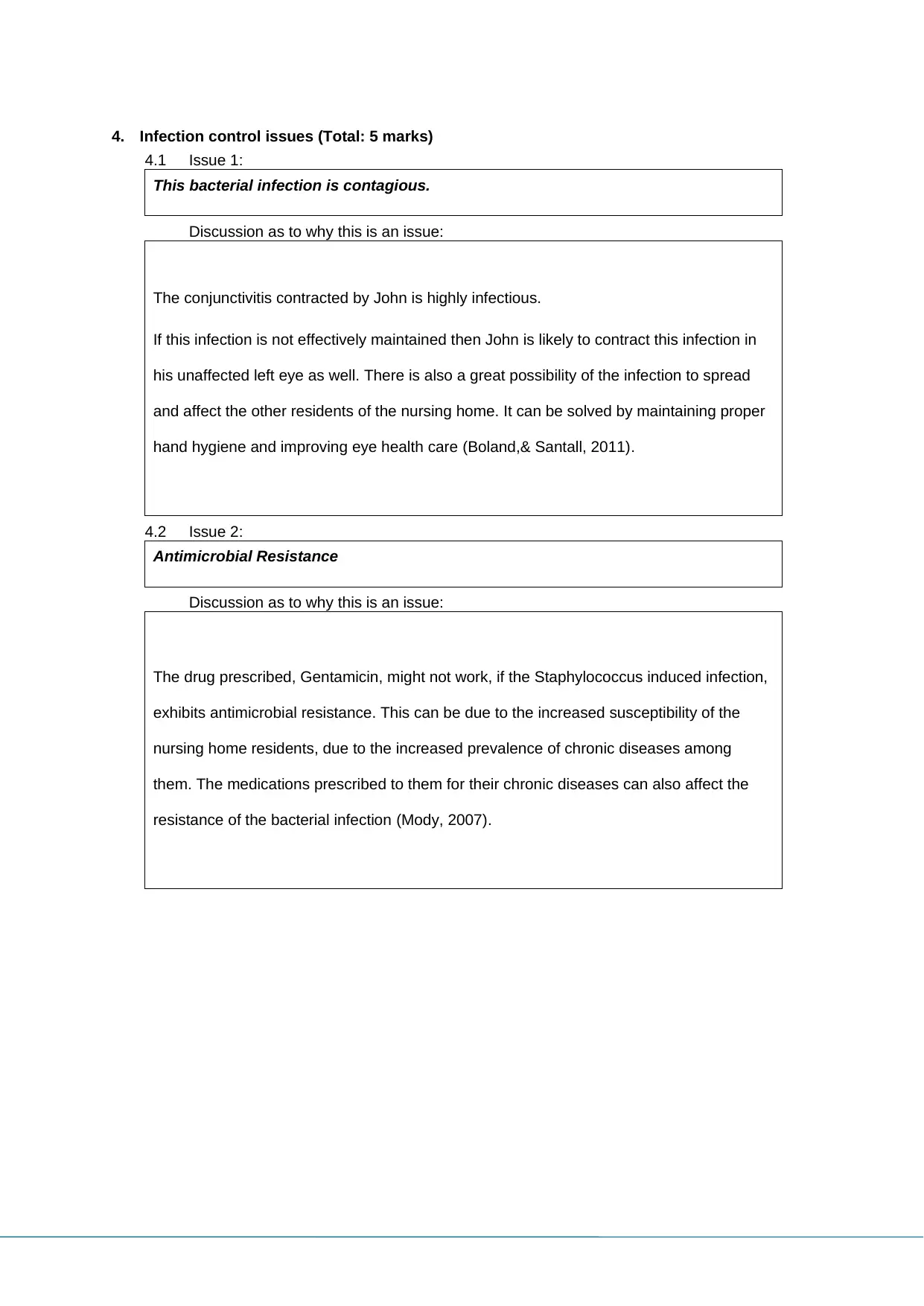
4. Infection control issues (Total: 5 marks)
4.1 Issue 1:
This bacterial infection is contagious.
Discussion as to why this is an issue:
The conjunctivitis contracted by John is highly infectious.
If this infection is not effectively maintained then John is likely to contract this infection in
his unaffected left eye as well. There is also a great possibility of the infection to spread
and affect the other residents of the nursing home. It can be solved by maintaining proper
hand hygiene and improving eye health care (Boland,& Santall, 2011).
4.2 Issue 2:
Antimicrobial Resistance
Discussion as to why this is an issue:
The drug prescribed, Gentamicin, might not work, if the Staphylococcus induced infection,
exhibits antimicrobial resistance. This can be due to the increased susceptibility of the
nursing home residents, due to the increased prevalence of chronic diseases among
them. The medications prescribed to them for their chronic diseases can also affect the
resistance of the bacterial infection (Mody, 2007).
4.1 Issue 1:
This bacterial infection is contagious.
Discussion as to why this is an issue:
The conjunctivitis contracted by John is highly infectious.
If this infection is not effectively maintained then John is likely to contract this infection in
his unaffected left eye as well. There is also a great possibility of the infection to spread
and affect the other residents of the nursing home. It can be solved by maintaining proper
hand hygiene and improving eye health care (Boland,& Santall, 2011).
4.2 Issue 2:
Antimicrobial Resistance
Discussion as to why this is an issue:
The drug prescribed, Gentamicin, might not work, if the Staphylococcus induced infection,
exhibits antimicrobial resistance. This can be due to the increased susceptibility of the
nursing home residents, due to the increased prevalence of chronic diseases among
them. The medications prescribed to them for their chronic diseases can also affect the
resistance of the bacterial infection (Mody, 2007).
⊘ This is a preview!⊘
Do you want full access?
Subscribe today to unlock all pages.

Trusted by 1+ million students worldwide
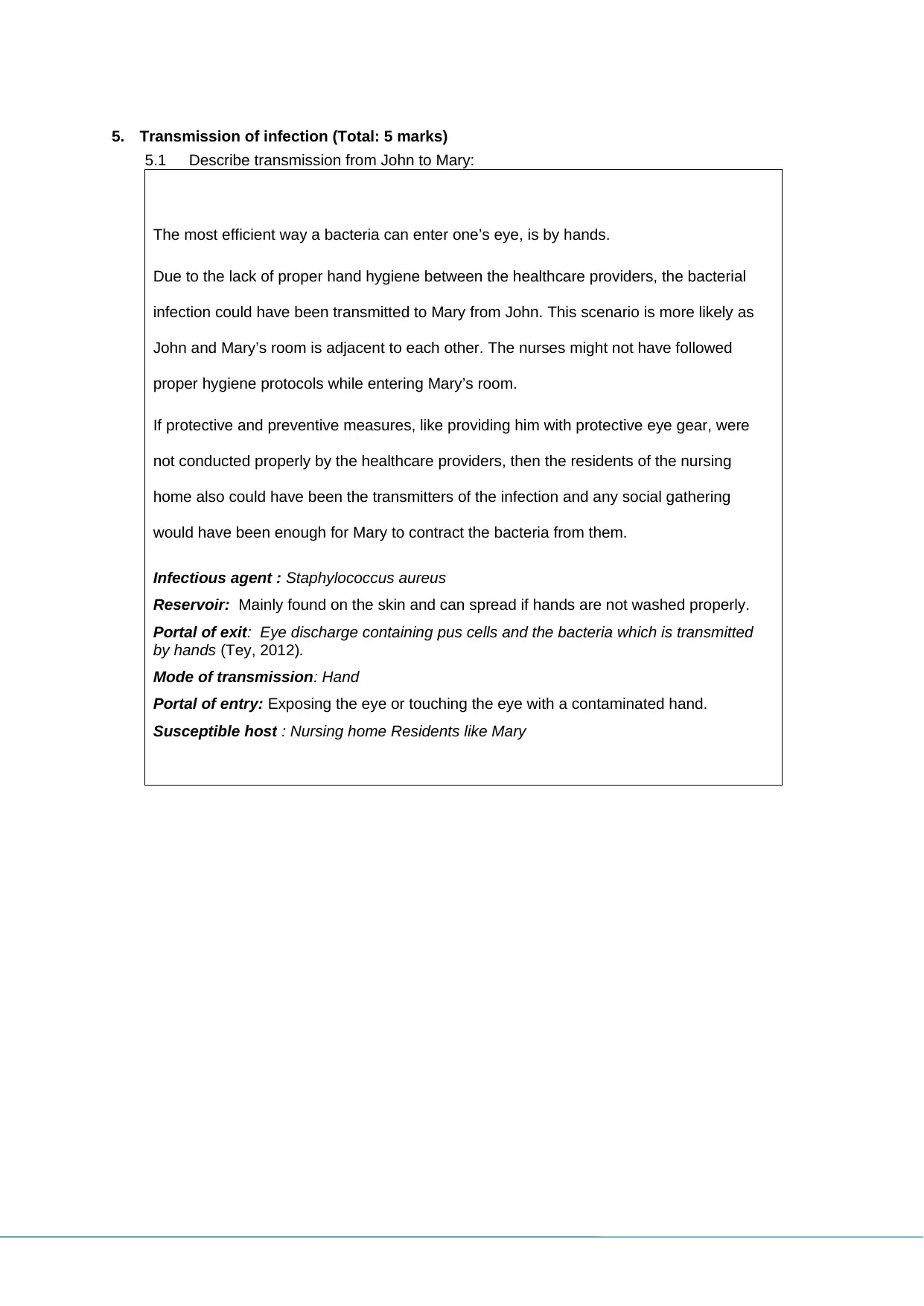
5. Transmission of infection (Total: 5 marks)
5.1 Describe transmission from John to Mary:
The most efficient way a bacteria can enter one’s eye, is by hands.
Due to the lack of proper hand hygiene between the healthcare providers, the bacterial
infection could have been transmitted to Mary from John. This scenario is more likely as
John and Mary’s room is adjacent to each other. The nurses might not have followed
proper hygiene protocols while entering Mary’s room.
If protective and preventive measures, like providing him with protective eye gear, were
not conducted properly by the healthcare providers, then the residents of the nursing
home also could have been the transmitters of the infection and any social gathering
would have been enough for Mary to contract the bacteria from them.
Infectious agent : Staphylococcus aureus
Reservoir: Mainly found on the skin and can spread if hands are not washed properly.
Portal of exit: Eye discharge containing pus cells and the bacteria which is transmitted
by hands (Tey, 2012).
Mode of transmission: Hand
Portal of entry: Exposing the eye or touching the eye with a contaminated hand.
Susceptible host : Nursing home Residents like Mary
5.1 Describe transmission from John to Mary:
The most efficient way a bacteria can enter one’s eye, is by hands.
Due to the lack of proper hand hygiene between the healthcare providers, the bacterial
infection could have been transmitted to Mary from John. This scenario is more likely as
John and Mary’s room is adjacent to each other. The nurses might not have followed
proper hygiene protocols while entering Mary’s room.
If protective and preventive measures, like providing him with protective eye gear, were
not conducted properly by the healthcare providers, then the residents of the nursing
home also could have been the transmitters of the infection and any social gathering
would have been enough for Mary to contract the bacteria from them.
Infectious agent : Staphylococcus aureus
Reservoir: Mainly found on the skin and can spread if hands are not washed properly.
Portal of exit: Eye discharge containing pus cells and the bacteria which is transmitted
by hands (Tey, 2012).
Mode of transmission: Hand
Portal of entry: Exposing the eye or touching the eye with a contaminated hand.
Susceptible host : Nursing home Residents like Mary
Paraphrase This Document
Need a fresh take? Get an instant paraphrase of this document with our AI Paraphraser
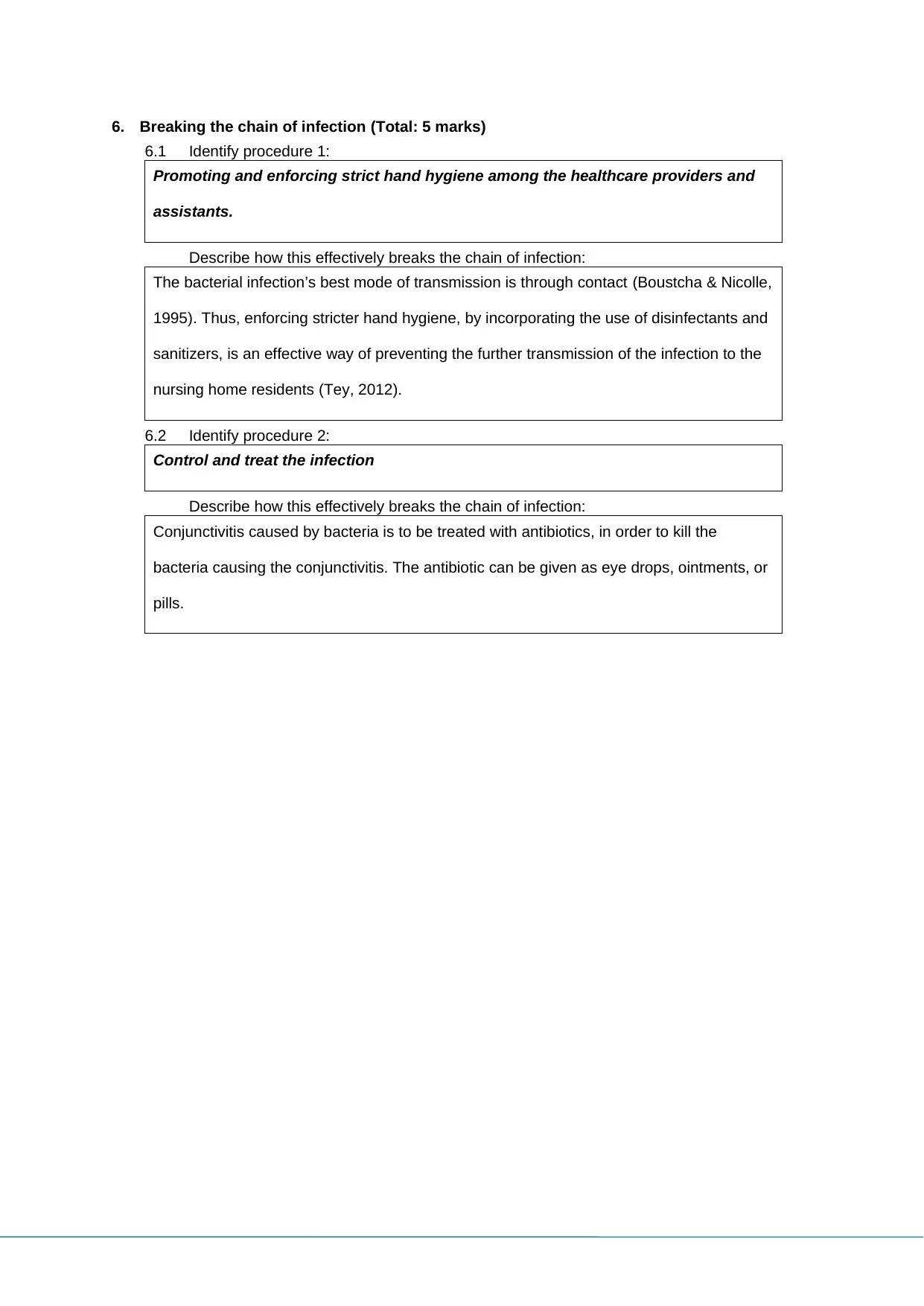
6. Breaking the chain of infection (Total: 5 marks)
6.1 Identify procedure 1:
Promoting and enforcing strict hand hygiene among the healthcare providers and
assistants.
Describe how this effectively breaks the chain of infection:
The bacterial infection’s best mode of transmission is through contact (Boustcha & Nicolle,
1995). Thus, enforcing stricter hand hygiene, by incorporating the use of disinfectants and
sanitizers, is an effective way of preventing the further transmission of the infection to the
nursing home residents (Tey, 2012).
6.2 Identify procedure 2:
Control and treat the infection
Describe how this effectively breaks the chain of infection:
Conjunctivitis caused by bacteria is to be treated with antibiotics, in order to kill the
bacteria causing the conjunctivitis. The antibiotic can be given as eye drops, ointments, or
pills.
6.1 Identify procedure 1:
Promoting and enforcing strict hand hygiene among the healthcare providers and
assistants.
Describe how this effectively breaks the chain of infection:
The bacterial infection’s best mode of transmission is through contact (Boustcha & Nicolle,
1995). Thus, enforcing stricter hand hygiene, by incorporating the use of disinfectants and
sanitizers, is an effective way of preventing the further transmission of the infection to the
nursing home residents (Tey, 2012).
6.2 Identify procedure 2:
Control and treat the infection
Describe how this effectively breaks the chain of infection:
Conjunctivitis caused by bacteria is to be treated with antibiotics, in order to kill the
bacteria causing the conjunctivitis. The antibiotic can be given as eye drops, ointments, or
pills.
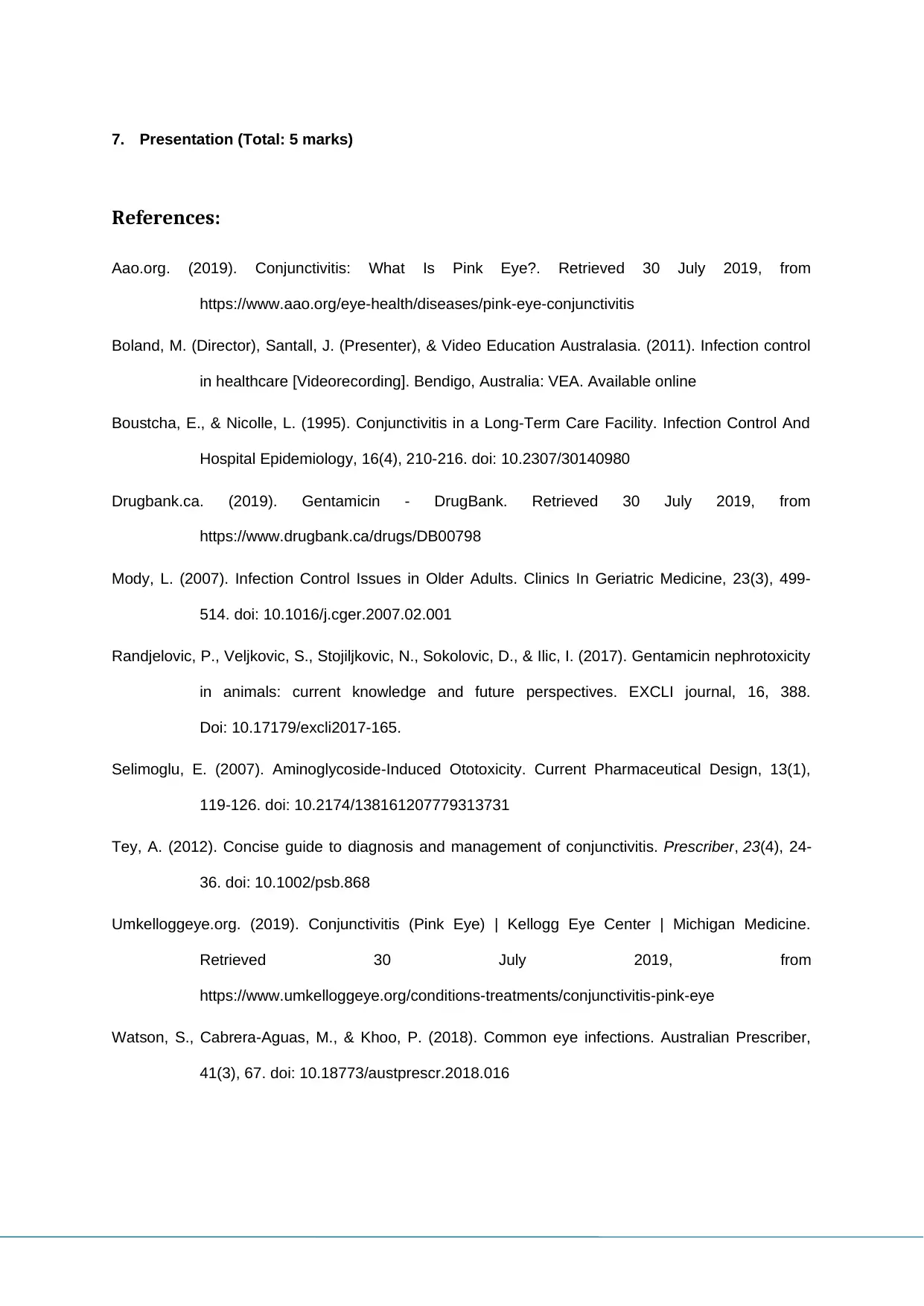
7. Presentation (Total: 5 marks)
References:
Aao.org. (2019). Conjunctivitis: What Is Pink Eye?. Retrieved 30 July 2019, from
https://www.aao.org/eye-health/diseases/pink-eye-conjunctivitis
Boland, M. (Director), Santall, J. (Presenter), & Video Education Australasia. (2011). Infection control
in healthcare [Videorecording]. Bendigo, Australia: VEA. Available online
Boustcha, E., & Nicolle, L. (1995). Conjunctivitis in a Long-Term Care Facility. Infection Control And
Hospital Epidemiology, 16(4), 210-216. doi: 10.2307/30140980
Drugbank.ca. (2019). Gentamicin - DrugBank. Retrieved 30 July 2019, from
https://www.drugbank.ca/drugs/DB00798
Mody, L. (2007). Infection Control Issues in Older Adults. Clinics In Geriatric Medicine, 23(3), 499-
514. doi: 10.1016/j.cger.2007.02.001
Randjelovic, P., Veljkovic, S., Stojiljkovic, N., Sokolovic, D., & Ilic, I. (2017). Gentamicin nephrotoxicity
in animals: current knowledge and future perspectives. EXCLI journal, 16, 388.
Doi: 10.17179/excli2017-165.
Selimoglu, E. (2007). Aminoglycoside-Induced Ototoxicity. Current Pharmaceutical Design, 13(1),
119-126. doi: 10.2174/138161207779313731
Tey, A. (2012). Concise guide to diagnosis and management of conjunctivitis. Prescriber, 23(4), 24-
36. doi: 10.1002/psb.868
Umkelloggeye.org. (2019). Conjunctivitis (Pink Eye) | Kellogg Eye Center | Michigan Medicine.
Retrieved 30 July 2019, from
https://www.umkelloggeye.org/conditions-treatments/conjunctivitis-pink-eye
Watson, S., Cabrera-Aguas, M., & Khoo, P. (2018). Common eye infections. Australian Prescriber,
41(3), 67. doi: 10.18773/austprescr.2018.016
References:
Aao.org. (2019). Conjunctivitis: What Is Pink Eye?. Retrieved 30 July 2019, from
https://www.aao.org/eye-health/diseases/pink-eye-conjunctivitis
Boland, M. (Director), Santall, J. (Presenter), & Video Education Australasia. (2011). Infection control
in healthcare [Videorecording]. Bendigo, Australia: VEA. Available online
Boustcha, E., & Nicolle, L. (1995). Conjunctivitis in a Long-Term Care Facility. Infection Control And
Hospital Epidemiology, 16(4), 210-216. doi: 10.2307/30140980
Drugbank.ca. (2019). Gentamicin - DrugBank. Retrieved 30 July 2019, from
https://www.drugbank.ca/drugs/DB00798
Mody, L. (2007). Infection Control Issues in Older Adults. Clinics In Geriatric Medicine, 23(3), 499-
514. doi: 10.1016/j.cger.2007.02.001
Randjelovic, P., Veljkovic, S., Stojiljkovic, N., Sokolovic, D., & Ilic, I. (2017). Gentamicin nephrotoxicity
in animals: current knowledge and future perspectives. EXCLI journal, 16, 388.
Doi: 10.17179/excli2017-165.
Selimoglu, E. (2007). Aminoglycoside-Induced Ototoxicity. Current Pharmaceutical Design, 13(1),
119-126. doi: 10.2174/138161207779313731
Tey, A. (2012). Concise guide to diagnosis and management of conjunctivitis. Prescriber, 23(4), 24-
36. doi: 10.1002/psb.868
Umkelloggeye.org. (2019). Conjunctivitis (Pink Eye) | Kellogg Eye Center | Michigan Medicine.
Retrieved 30 July 2019, from
https://www.umkelloggeye.org/conditions-treatments/conjunctivitis-pink-eye
Watson, S., Cabrera-Aguas, M., & Khoo, P. (2018). Common eye infections. Australian Prescriber,
41(3), 67. doi: 10.18773/austprescr.2018.016
⊘ This is a preview!⊘
Do you want full access?
Subscribe today to unlock all pages.

Trusted by 1+ million students worldwide
1 out of 9
Related Documents
Your All-in-One AI-Powered Toolkit for Academic Success.
+13062052269
info@desklib.com
Available 24*7 on WhatsApp / Email
![[object Object]](/_next/static/media/star-bottom.7253800d.svg)
Unlock your academic potential
Copyright © 2020–2025 A2Z Services. All Rights Reserved. Developed and managed by ZUCOL.





